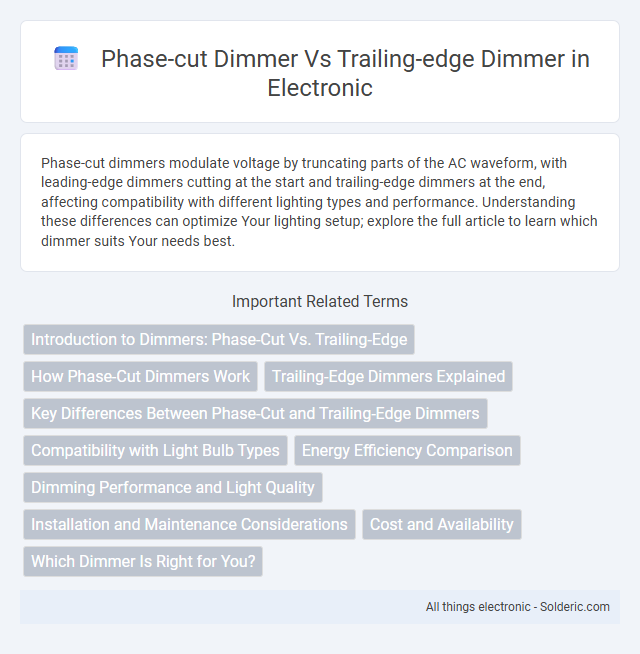Phase-cut dimmers modulate voltage by truncating parts of the AC waveform, with leading-edge dimmers cutting at the start and trailing-edge dimmers at the end, affecting compatibility with different lighting types and performance. Understanding these differences can optimize Your lighting setup; explore the full article to learn which dimmer suits Your needs best.
Comparison Table
| Feature | Phase-Cut Dimmer | Trailing-Edge Dimmer |
|---|---|---|
| Operating Principle | Chops the leading edge of the AC waveform | Chops the trailing edge of the AC waveform |
| Compatibility | Incandescent, halogen, some LED bulbs | LED, CFL, electronic transformers, newer lamps |
| Noise Level | Higher humming noise | Low noise operation |
| Flicker | Possible flickering with LEDs | Reduced flicker with dimmable LEDs |
| Thermal Efficiency | Moderate heat generation | More efficient, less heat |
| Lifespan | Shorter lifespan with LEDs | Longer lifespan, safer for LEDs |
| Price | Generally lower cost | Typically higher cost |
| Use Case | Best for traditional bulbs and simple circuits | Ideal for LED and electronic load dimming |
Introduction to Dimmers: Phase-Cut Vs. Trailing-Edge
Phase-cut dimmers regulate light intensity by modifying the voltage waveform, with leading-edge dimmers cutting the initial portion of the AC sine wave and trailing-edge dimmers cutting the final portion. Leading-edge dimmers are commonly used for incandescent and halogen bulbs, while trailing-edge dimmers are optimized for LED and low-voltage lighting due to their compatibility with electronic drivers and reduced noise. Trailing-edge dimmers provide smoother dimming, enhanced energy efficiency, and better protection against flicker compared to traditional phase-cut methods.
How Phase-Cut Dimmers Work
Phase-cut dimmers work by modifying the AC waveform to control light brightness, either by cutting the leading edge (leading-edge dimmers) or the trailing edge (trailing-edge dimmers) of the voltage signal. Leading-edge dimmers use a TRIAC to abruptly cut the front part of the sine wave, suitable for incandescent and halogen bulbs but less effective with LEDs. Trailing-edge dimmers employ MOSFET or IGBT transistors to softly cut the end of the waveform, providing smoother dimming and compatibility with modern LED lighting, ensuring your lighting performance matches your needs.
Trailing-Edge Dimmers Explained
Trailing-edge dimmers use electronic components like MOSFETs or IGBTs to cut the end of each AC waveform, resulting in smoother and quieter light dimming compared to phase-cut dimmers that cut the beginning of the waveform. These dimmers offer better compatibility with LED and CFL bulbs, reducing flicker and extending bulb lifespan. Your lighting system benefits from improved energy efficiency and enhanced dimming precision when using trailing-edge dimmers.
Key Differences Between Phase-Cut and Trailing-Edge Dimmers
Phase-cut dimmers, often called leading-edge dimmers, control light intensity by cutting the beginning of the AC waveform and are compatible mainly with incandescent and halogen bulbs. Trailing-edge dimmers cut the end of the AC waveform, providing smoother, quieter performance and better compatibility with LED and low-voltage lighting systems. The key differences include waveform control methods, compatibility with bulb types, and the quality of dimming performance, with trailing-edge dimmers offering more energy efficiency and reduced flickering for modern lighting technologies.
Compatibility with Light Bulb Types
Phase-cut dimmers work effectively with incandescent and halogen bulbs, using leading-edge technology that cuts the beginning of the AC waveform to control brightness. Trailing-edge dimmers are optimized for compatibility with LED and CFL bulbs, smoothly cutting the end of the waveform to reduce flicker and extend bulb lifespan. Your choice impacts performance and bulb longevity, as trailing-edge dimmers generally provide better results with modern energy-efficient lighting.
Energy Efficiency Comparison
Phase-cut dimmers, including leading-edge and trailing-edge types, affect energy efficiency differently due to their switching methods. Trailing-edge dimmers typically offer higher energy efficiency by providing smoother and more precise control over LED drivers, reducing power loss and heat generation compared to leading-edge dimmers. This improved efficiency results in less wasted energy and longer lifespan for connected lighting systems.
Dimming Performance and Light Quality
Phase-cut dimmers excel in compatibility with incandescent and halogen bulbs, providing smooth dimming but may cause flickering or noise with LED lights. Trailing-edge dimmers offer superior dimming performance for LED and CFL bulbs, ensuring flicker-free and quieter operation with enhanced light quality. Your choice impacts the stability and consistency of light output, making trailing-edge dimmers preferable for modern energy-efficient lighting solutions.
Installation and Maintenance Considerations
Phase-cut dimmers typically require straightforward installation compatible with most incandescent and halogen bulbs, but they may cause flickering or buzzing when used with LED lights, demanding specific load compatibility checks. Trailing-edge dimmers, designed for LED and CFL lighting, offer smoother operation with less heat generation, extending the lifespan of connected fixtures and reducing maintenance frequency. Correct installation involves ensuring the dimmer matches the bulb type and load capacity, while maintenance primarily focuses on verifying wiring integrity and replacing dimmers showing signs of overheating or inconsistent dimming performance.
Cost and Availability
Phase-cut dimmers generally cost less and are widely available in standard electrical supply stores due to their long-standing use with traditional incandescent and halogen bulbs. Trailing-edge dimmers, designed for compatibility with LED and other low-wattage devices, tend to be more expensive and may require sourcing from specialized retailers or online platforms. Your choice between these dimmers should consider budget constraints and the ease of finding the appropriate model for your lighting system.
Which Dimmer Is Right for You?
Choosing the right dimmer depends on your lighting needs and fixture compatibility. Phase-cut dimmers, including leading-edge types, work best with incandescent and halogen bulbs, providing smooth, flicker-free dimming. If you use LED or CFL bulbs, a trailing-edge dimmer offers better performance, reduced noise, and improved efficiency for Your lighting setup.
phase-cut dimmer vs trailing-edge dimmer Infographic

 solderic.com
solderic.com